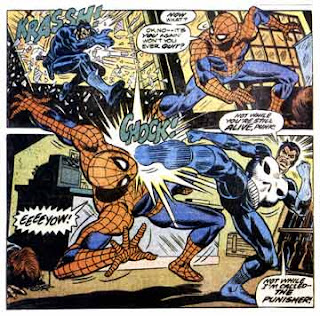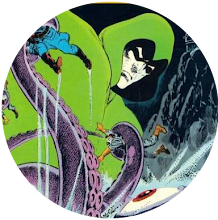 |
| Peter Parker's just found out that not everyone loves Ross Andru's artwork. |
If I was American, I of course would reply, "I don't know. Maybe they once drew him with two left feet or something."
To which they'd reply, "Not error, you buffoon. Era. It has no R on the end of it."
To which I'd reply, "The letter R means nothing to me unless it's in the middle of a word."
Thus shall I have made a complete and total fool of myself.
Fortunately, being English, everyone around me pronounces it, "Eera," meaning I need never fear making such a mistake every time I leave the house.
I do of course have to fear contracting pneumonia from the icy rain that constantly lashes my home town, every time I leave the house, but at least I shall die unembarrassed.
 |
| Mary Jane's boobs make a very strange noise whenever Peter Parker sticks his head between them. |
In my blithe ignorance, I'd always assumed this was the consensus. After all, how could anyone not concur with such an indisputable sentiment?
 |
| Nope. Can't think of a witty caption. |
I have to say it baffles me. I thought it was undeniably the strongest in the wall-crawler's history. We had the aftermath of the death of Gwen Stacy, with Peter Parker and Mary Jane growing ever-closer. We got the return of old foes like the Scorpion and the Molten Man, new incarnations of old foes like the Vulture and Mysterio, and a bunch of new opponents like the Grizzly, the Tarantula and the Punisher.
Most of all we got the wicked machinations of the Jackal. Admittedly the revelation that the Jackal was Professor Warren was as stupid a denouement as has ever been inflicted on any readership but, if you were willing to turn a blind eye to that then it was still great stuff as the flappy-eared felon worked his evil plans.
But it seems the problem some people have with the Ross Andru era is Ross Andru. It's something that's always baffled me. I've always thought he was perfect for the strip. In his use of wild angles, perspective and layouts, he echoed Gil Kane's approach to capturing the web-slinger's action sequences but, conversely he also had the ability to perfectly capture the more everyday aspects of Peter Parker's life. No, his characters didn't look like real people but something about Andru's story-telling meant that, for me, Peter Parker and his cast never seemed more alive nor more real than when he drew them, and that's why he has always been and I suspect always will be my favourite Spider-Man artist.








































































7 comments:
Steve,
I've been reading your articles on the Spidey reprints and Ross Andru and it brought back a lot of memories. Basically, I agree with every word you wrote. Andru is the most under-rated artist on Spidey. He needed a good inker but when he had that, it was just wonderful. No one made NYC a 'character' like he did. If only he was still around. Most of the guys currently working in the industry couldn't lace his boots.
Robert.
Hi, Robert. It's always nice to see Andru getting some love. It does seem to me that he's often been unfairly overlooked and I've never understood why.
Frankly, I think that Mr Andru was the most 'realistic-image'-creating artist that the magazine had had at that point--possibly the most realistic-image-creating artist it's ever had. I think the unspoken(?) problem with Ross Andru is that he was a time-consuming artist--he couldn't be rushed; and that didn't sit well with a monthly title like Amazing Spider-Man. Just the other night I was re-reading #136 (the issue where Harry bombs the flat and lands MJ in hospital), and many panels looked unfinished to me. Take a look for yourself, Steve; you no doubt own a copy. Then again, maybe someone else (usually uncredited) drew the backgrounds and such, as was often the case in those days.
Spider-Man comics have always been at their best when the artist suits the era. Ditko, with his cartoonish style, was perfect for the early to mid '60s. Romita, with occasional help from Don Heck and Jim Mooney, truly captured the mid to late '60s era. Gil Kane came along just in time for the early '70s; his panels of Gwen Stacy sitting alone in her flat in #102 linger on in my mind. Years later, Todd McFarlane and Eric Larsen fit the bill for the late '80s / early '90s period. And so it was for Mr Andru: he captured the artistic realism and doubt and devolution of the mid 1970s. Interestingly, the other eras of Spider-Man comics are largely irrelevant, and have not stood the test of time.
Hi, RW. A fair bit back I read an interview with Dick Giordano where he spoke about the creation of the first Superman/Spider-Man team-up. He spoke of Andru's eyesight difficulties meaning Andru had problems meeting the deadline for the story and therefore left a lot of detail out for Giordano to add at the inking stage. Perhaps that's the explanation for the problems you detected in issue #136.
Poor eyesight, eh? Makes sense. I just consulted with Crapipedia--er, Wikipedia, and if one can believe anything one reads there, Mr Andru passed away at age 66 in 1993.
Actually, that's a good idea for one of your blog installments, Steve: a listing of the major artists and writers we grew up on and have since joined the Great Majority. Gil Kane is gone...John Buscema is gone...Bill Everett and Artie Simek are long gone...etc...etc....
Huge fan of the great Ross Andru here and eager to kick the balls of any short sighted one (no pun intended) who might dare to disagree!
I heard about Andru's eyesight failing toward the end of his career but obviously not so early on during his ASM run.
It's a shame that he is so underappreciated.
Still, he's far from being forgotten and I'm confident that time will bring justice and rightfully put him a place of choice in the greatest comic creators hall of fame.
I was introduced to Spidey during this stellar era and for me this series and this period epitomizes the bronze age. The great Andru did for Spidey what Buscema did for Conan and Starlin did for Warlock. The Andru period turned my casual interest in comics into a passion.
Post a Comment